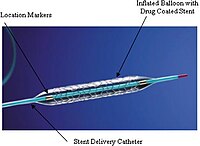
Photo from wikipedia
BACKGROUND A newly developed dental implant system combining advancements in surface chemistry, topography, nanostructure, color, and surface energy aims to address biological challenges and expand clinical applications. PURPOSE To assess… Click to show full abstract
BACKGROUND A newly developed dental implant system combining advancements in surface chemistry, topography, nanostructure, color, and surface energy aims to address biological challenges and expand clinical applications. PURPOSE To assess the short- and long-term safety and efficacy of a novel, gradually anodized dental implant surface/anodized abutment. MATERIALS AND METHODS Twenty-four Yucatan mini pigs (20-24 months old) received two dental implants in each jaw quadrant. Each site was randomized to receive either a commercially available anodized implant/machined abutment or a gradually anodized implant/anodized abutment with a protective layer. Animals were euthanized at 3, 6, and 13 weeks. Microcomputed tomography and histological analyses were performed. RESULTS No significant histological differences in inflammation scores, epithelium length, bone-to-implant contact, or bone density were observed between groups for any healing time. Mucosal height was significantly higher at 3 weeks for controls (Δ = 0.2 mm); no differences were observed at 6 and 13 weeks. No significant differences in radiographic bone volume, bone-to-implant contact, trabecular thickness, and crestal bone levels were observed, irrespective of healing time. Trabecular spacing was borderline significant at 3 weeks in favor of the test implant sites; no differences were observed at 6 weeks. No significant differences were observed between experimental groups at 13 weeks. CONCLUSIONS The new implant system yielded results comparable to a commercially available predicate device.
Journal Title: Clinical implant dentistry and related research
Year Published: 2019
Link to full text (if available)
Share on Social Media: Sign Up to like & get
recommendations!